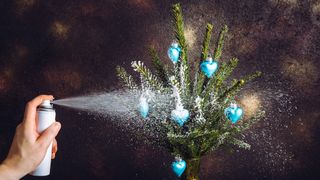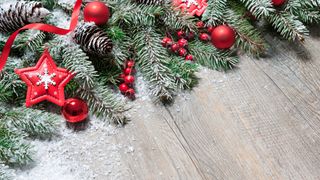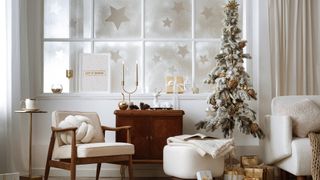There’s nothing like a touch of snow spray to bring festive vibes to your interior over the holiday season. It's a festive way to decorate a tree, to create beautiful stencil patterns on windows and mirrors, and it can be lightly sprayed on wreaths and table centerpieces.
Artificial snow spray can bring that extra joy to your festive decorations and ensure that everyone who sees it has a white Christmas. However, experiencing a snow-filled holiday can come at a cost to your interior, with experts warning that it can cause tough cleaning tasks and can even cause permanent damage to your furniture.
Although you can pick up a can of artificial snow spray for under $10 at online retailers, it may cost you more in hard work and furniture repairs if you don’t take care when using this quick decorative snow hack. It's definitely one Christmas decorating mistake to avoid.
Why you should be careful when using snow spray

The issue with using snow spray is that the chemicals in the mix can damage furnishings. “Acetone and propellants can interact with various finishes, paints, and fabrics, leading to discoloration, residue buildup, or even permanent damage if not used carefully,” says Sam Deeble, furniture expert at Woods Furniture.
However, once you know what damage snow spray can cause, you can use it more wisely and protect the parts of your interior that are at risk.
How to protect your home
Glass windows, mirror or plastic

When you think of artificial snow scenes, a scenic window display with festive stenciled designs probably comes to mind. The decorative idea is relatively easy to achieve without needing too much artistic talent, however, cleaning up once the holiday season is more of a challenge, especially if you've choose a complex design.
“Glass and plastic surfaces are typically safer options for snow spray application because they are non-porous and easier to clean,” says Deeble, “However, intricate designs or textures on these surfaces, such as etched glass or detailed plastic moldings, can trap the spray particles. This can result in uneven appearances and make cleanup more challenging.”
To overcome this issue, Keeble recommends opting for a smooth, flat surface where the snow spray can be applied evenly and cleaned without too much elbow grease.
Fabric and upholstery

If your plan is to spruce up your Christmas tree with snow spray, be wary of the surrounding soft furnishings. While spraying the tree inside your home is much easier than bringing it through multiple doorways once sprayed, it can lead to mishaps.
“Fabric and upholstered furniture are particularly susceptible to snow spray residue, as the porous nature of fabric can trap particles, making it challenging to remove,” says Deeble. “Over time, this residue may attract dust or dirt, leading to visible staining and an overall dingy appearance.”
But that’s not the only problem. The acetone and propellants in the spray can react with certain fabrics, causing discoloration and fading and weakening the fibers. While it might not be so visible on heavy-weight fabrics, it will be more obvious on delicate and light-weight materials.
Take care of yourself
Apart from protecting your furniture while using snow spray, you also need to protect yourself. Just like when using any aerosol, make sure the room is well ventilated, and don’t use the spray near open flames.
To prevent your soft furnishings from becoming damaged, Deeble says, “Cover nearby upholstery with protective sheets or plastic while decorating to prevent accidental overspray.”
Smaller items of upholstered furniture, such as single chairs and footstools, can be moved out of the way while decorating, and then moved back once the task is complete.
However, if any fabrics do come into contact with snow spray, act fast to minimize the risk of permanent stains or damage. “Vacuum up any loose particles immediately and spot-clean the area with a fabric-safe cleaner,” advises Deeble.
Wooden furniture

One material particularly vulnerable to damage from snow spray is wood, which is damaged by the acetate and propellants within the spray. Deeble explains, “These [chemicals] can react with the finish, causing discoloration, dullness, or even a sticky residue that can be difficult to remove. Over time, such damage can alter the furniture’s appearance and lead to costly refinishing.”
However, once you know the damage that snow spray can cause to wooden furniture, it doesn’t mean you have to stop using the spray. You just need to take some extra precautions before pressing the nozzle.
Deeble suggests covering the surrounding area in sheets or plastic before applying the spray. An old blanket or large towel will also do the trick, plus it’s worth pinning down any coverings with masking tape to keep it in place while spraying.
But if any spray does land on wood, she recommends, “Clean it off immediately using a soft, damp cloth and a gentle cleaner appropriate for the finish. Fast action is important to prevent the residue from setting in and causing permanent damage.”

If snow spray falls on metal it is less of a problem than other materials, but it’s still best to clean it up straight away. “Long exposure to the spray can leave a sticky residue, especially if not cleaned up quickly,” says Deeble. “This residue may attract dust, grime or moisture, creating an environment that can lead to rust or corrosion over time.”
She also warns that the residue will be more difficult to remove from decorative metallic objects with intricate patterns or grooves, which can cause its surface to appear lackluster rather than shiny.
More from Tom's guide
- Discover 7 best scents to give your home a Christmas vibe
- And 7 festive ways to spruce up your dinner table
- Plus, 5 best houseplants to gift over the holidays





















 English (US) ·
English (US) ·